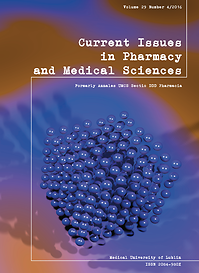Characteristics of oral probiotics – a review
DOI:
https://doi.org/10.1515/cipms-2016-0002Keywords:
probiotics, oral cavityAbstract
Probiotics are a group of microorganisms able to have a positive influence on a host organism when applied in adequate amounts. They are grouped either as: bacteria (mainly Lactobacillus spp and Bifidobacterium) or fungi (Saccharomyces boulardii). Recent studies have revealed many opportunities for their use in several fields of medicine, such as in: reducing the level of cholesterol in the body, cancer therapy, human immune system regulation, skin regeneration, pancreas necrosis, cirrhosis of liver treatment, regulation of post-antibiotic bowel function, constipation and digestive disorders in infants. Probiotics efficacy has also been demonstrated in oral cavity malfunctions. With the use of modern scientific methods, probiotics have the potential to become an important part of the daily diet and a natural drug supplementation in severe diseases.
References
1. Ahola A.J. et al.: Short-term consumption of probiotic-containing cheese and its effect on dental caries risk factors. Arch. Oral Biol., 47, 799, 2002.
2. Burton J.P. et al.: Persistence of the oral probiotic Streptococcus salivarius M18 is dose dependent and megaplasmid transfer can augment their bacteriocin production and adhesion characteristics. PloSOne.,8: e65991, 2013.
3. Chiang S¬S, Pan T¬M. Beneficial effects of Lactobacillus paracasei subsp. paracasei NTU 101 and its fermented products. Appl. Microbiol. Biotechnol., 93, 903, 2012.
4. de Vrese M, Schrezenmeir J. Probiotics, prebiotics, and synbiotics. Adv. Biochem. Eng. Biotechnol., 111, 1, 2008.
5. Guyonnet D. et al.: Effect of a fermented milk containing Bifidobacterium animalis DN-173 010 on the health-¬related quality of life and symptoms in irritable bowel syndrome in adults in primary care: a multicentre, randomized, double¬blind, controlled trial. Aliment. Pharmacol. Ther., 26, 475, 2007.
6. Hasslöf P. et al.: Early intervention with probiotic Lactobacillus paracasei F19 has no long¬term effect on caries experience. Caries Res., 47, 559, 2013.
7. Isselbacher K.J.: Irritable bowel syndrome: the possible benefits of probiotics. Postgrad. Med., 117, 7, 2005.
8. Kleerebezem M. et al.: Complete genome sequence of Lactobacillus plantarum WCFS1. Proc. Natl. Acad. Sci. U S A., 100, 1990, 2003.
9. Lee do K. et al.: Antimicrobial activity of Bifidobacterium spp. isolated from healthy adult Koreans against cariogenic microflora. Arch. Oral Biol., 56, 1047, 2011.
10. Lee S¬H, Kim Y¬J. A comparative study of the effect of probiotics on cariogenic biofilm model for preventing dental caries. Arch. Microbiol., 196, 601, 2014.
11. Lilly D.M., Stillwell R.H.: Probiotics: growth-promoting factors produced by microorganisms. Science, 147, 747, 1965.
12. Lin MY, Chang FJ. Antioxidative effect of intestinal bacteria Bifidobacterium longum ATCC 15708 and Lactobacillus acidophilus ATCC 4356. Dig. Dis. Sci., 45, 1617, 2000.
13. Manley K.J. et al.: Probiotic treatment of vancomycin¬-resistant enterococci: a randomised controlled trial. Med. J. Aust., 186, 454, 2007.
14. Masdea L. et al.: Antimicrobial activity of Streptococcus salivarius K12 on bacteria involved in oral malodour. Arch. Oral Biol., 57, 1041, 2012.
15. Oh P.L. et al.: Diversification of the gut symbiont Lactobacillus reuteri as a result of host¬-driven evolution. ISME J., 4, 377, 2010.
16. Rajkowska K., Kunicka-Styczyńska A.: Probiotic activity of Saccharomyces cerevisiae var. boulardii against human pathogens. Food Technol. Biotechnol., 50, 230, 2012.
17. Soccol C.R. et al.: The potential of probiotics: a review. Food Technol. Biotechnol., 48, 413, 2010.
18. Twetman S.: Treatment protocols: nonfluoride management of the caries disease process and available diagnostics. Dent. Clin. North Am., 54, 527, 2010.
Downloads
Published
Issue
Section
License
Copyright (c) 2016 Authors

This work is licensed under a Creative Commons Attribution-NonCommercial-NoDerivatives 3.0 Unported License.


